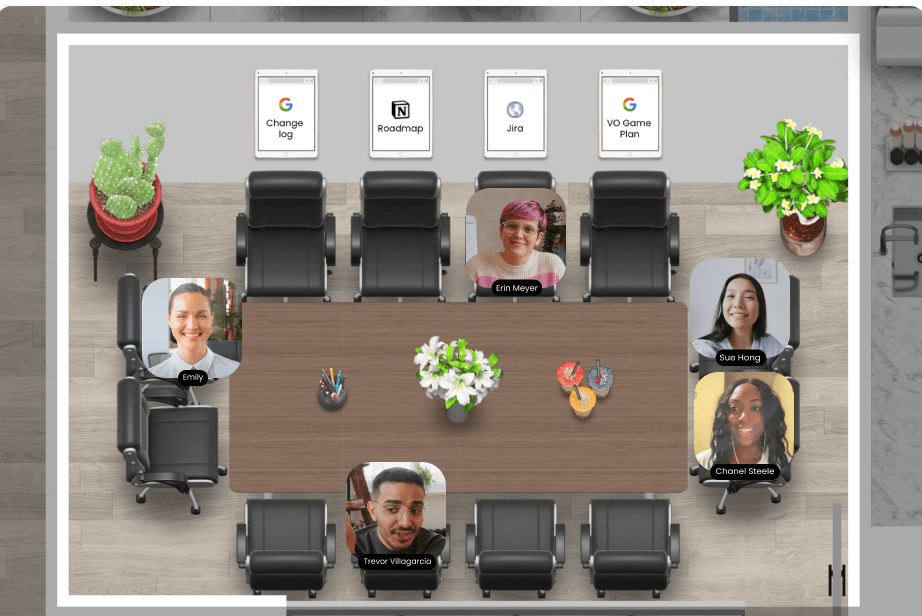Are you tired of attending back-to-back meetings that leave you with little time to focus on your actual work? You’re not alone. In the era of remote work, the mantra “less meetings, more productivity” has never been more relevant. This blog post will guide you through strategies to avoid too many meetings and increase productivity, ultimately helping you reclaim your time and sanity.
Key takeaways
- Excessive meetings can lead to hidden costs for organizations. Optimize meeting times by setting clear objectives, limiting attendance and duration, and implementing a no-meeting day.
- Strategies such as defining clear objectives & agendas, restricting attendees & meeting duration, embracing asynchronous communication tools like Slack/Trello/Google Docs & introducing a no-meeting day help reduce time while building trust among team members.
- Adapting to remote work tools with an open attitude towards change helps increase productivity without the need of excessive meetings.
The hidden costs of excessive meetings

Meetings are often seen as a necessary evil; a way to keep everyone on the same page and make decisions. However, excessive meetings can have a detrimental effect on employee morale, efficiency, and organizational development. When teams rely heavily on meetings for updates and information dissemination, they can inadvertently create a culture that stifles productivity and hinders company progress, leading to unnecessary meetings.
We’ll now explore the hidden costs of excessive meetings in more detail.
Employee well-being

An abundance of so many meetings can lead to:
- Stress
- Dissatisfaction
- Disengagement Adversely affecting employee well-being. When roles and responsibilities are not clearly defined, individuals may feel disempowered and resort to numerous ineffective meetings.
Enhancing employee well-being requires us to optimize meeting time through:
- Clearly defined objectives and agendas
- Attendee limitations
- Restricted meeting durations
- The introduction of a no-meeting day.
Productivity loss
Productivity takes a hit when employees spend more time in meetings than on their assigned tasks, resulting in decreased output. Ineffective meetings can cause teams to spend time discussing irrelevant topics or involving people who should not be part of the decision-making process.
Reducing productivity loss and allowing your team to focus on their tasks can be achieved through fewer meetings that concentrate on essential issues.
Company progress
An abundance of meetings, including more meetings than necessary, can impede teams from concentrating on their strategic objectives and creative ideas. In flat structure companies, it can be difficult to determine individual roles and responsibilities, leading to a lack of empowerment among employees and an abundance of unproductive weekly meetings.
A company’s progress is directly affected by its ability to reduce meeting overload and focus on achieving its goals.
Strategies for reducing meeting time

Helping your team regain control of their schedules and refocus on their work can be achieved by implementing strategies that minimize meeting duration and improve scheduling meetings. By reducing the time spent in meetings, we will delve into three key strategies: defining clear objectives and agendas, restricting attendees and meeting duration, and introducing a no-meeting day. Creating a more efficient and productive work environment is possible by adopting these strategies.
Establish clear objectives and agendas
Establishing clear objectives and agendas for meetings can ensure that they are effective and efficient, thereby minimizing meeting time and reducing the occurrence of way too many meetings. The advantages of setting clear objectives and agendas include:
- Increased productivity
- Improved communication
- Heightened engagement
- More effective decision-making
- Bolstered morale for every team member
Constructing, establishing, and distributing the agenda in advance is suggested to ensure a more productive brainstorming meeting, reduce the meeting load, and facilitate the creation of effective meeting notes.
Limit attendees and meeting duration
Restricting attendance to necessary personnel and limiting meeting durations can help to preserve attention and efficiency, especially in recurring meetings. By focusing on inviting only essential meeting attendees and keeping meeting durations concise, you can ensure that meetings remain focused and productive. This approach not only optimizes the use of everyone’s time but also fosters a culture of mindfulness and respect for others’ schedules.
Implement a no-meeting day
A no-meeting day is a day of the work week where no meetings are scheduled, providing teams with an opportunity to refocus on priorities, take a break from meeting pressures, and increase productivity.
Implementing a no-meeting day can offer employees uninterrupted time for deep work and project advancement, ultimately leading to a more efficient and well-balanced workflow.
Embracing asynchronous communication

Asynchronous communication can facilitate a more efficient workflow by enabling team members to contribute at their own pace, thereby reducing the need for frequent meetings. By embracing asynchronous communication, you can create a more flexible and adaptable work environment that not only reduces meeting frequency but also improves team collaboration.
The upcoming subsections will cover tools for async collaboration and methods to strike a balance between synchronous and asynchronous communication.
Tools for async collaboration
Tools such as Slack, Trello, and Google Docs enable team members to contribute to projects in their own time. These tools provide a platform for effective communication between team members, enabling them to work on projects autonomously and at their own speed.
Utilizing tools for asynchronous collaboration can assist in minimizing the requirement for meetings, augmenting productivity, and enhancing team collaboration.
Balancing sync and async communication
Combining synchronous and asynchronous communication offers various advantages. Synchronous communication tools like Kumospace facilitate immediate collaboration and rapid decision-making, creating a sense of togetherness and teamwork.
Asynchronous communication, on the other hand, provides flexibility, reduces distractions, and allows for concentrated work. By utilizing both modes, teams can optimize productivity and maintain a healthy work-life balance.
Building trust and accountability among team members

Trust and accountability are crucial components of a highly functioning team. When team members trust one another and feel accountable for their work, the need for excessive meetings decreases.
We will examine two strategies to cultivate trust and accountability among team members: promoting open dialogue and establishing clear expectations and responsibilities.
Encourage open dialogue
Open dialogue and feedback can be instrumental in cultivating trust and understanding within a team. It enables team members to express themselves in a secure and respectful manner. To cultivate an environment that encourages open dialogue and feedback, consider the following:
- Establish clear expectations and guidelines for communication.
- Provide a secure platform for members to share their ideas and sentiments.
- Promote active listening and respect for diverse viewpoints.
By implementing these strategies, you can create a team culture that values open dialogue and feedback.
Set clear expectations and responsibilities

Defining precise expectations and responsibilities for team members, including direct reports, can foster accountability and minimize the requirement for regular follow-ups. Assigning a DRI (Directly Responsible Individual) for each project ensures that someone is accountable for the project’s success and reduces the need for constant check-ins.
By setting clear expectations and responsibilities, teams can work more efficiently and reduce the need for excessive meetings.
Adapting to new ways of working

Adapting to new ways of working can help teams increase productivity and reduce the need for meetings in 2023. We will investigate two strategies to adapt to the evolving work environment: the utilization of remote work tools and maintaining a flexible attitude towards change. The efficient navigation of the continually changing landscape of remote work and the creation of a more productive work environment can be facilitated by these strategies.
Embrace remote work tools
Utilizing remote work tools like Zoom, Asana, and Miro can streamline communication and collaboration within your team. These tools facilitate organization, enhance collaboration, and minimize the necessity for in-person meetings, thus increasing productivity.
Embracing remote work tools is essential in today’s digital work environment and can significantly improve your team’s efficiency.
Stay open to change
Stay open to change and continuously evaluate team processes to identify areas for improvement and reduce meeting frequency. By remaining flexible and open to new ideas, your team can effectively adapt to new ways of working and create a more efficient and productive work environment.
Optimizing Meetings with Kumospace: A Strategic Approach in 2023

Kumospace, a cutting-edge virtual office platform, offers unique solutions to the common problem of excessive meetings, which can drain productivity in the workplace.
Redefining Meetings with Kumospace
- Spontaneous Interaction: One of Kumospace's standout features is its ability to facilitate spontaneous interactions, akin to those in a physical office. This feature can significantly reduce the need for formal meetings. Employees can quickly resolve small issues or have brief discussions without the need to schedule a separate meeting, thereby saving time and maintaining flow in their workday.
- Virtual Office Layout: The platform's virtual office layout enables teams to create designated spaces for different purposes, such as quiet work zones or collaboration areas. This environment allows for more focused and efficient meetings when they do occur, as participants are in the right context and mindset for the meeting's purpose.
- Enhancing Engagement: Kumospace's interactive features, like spatial audio and video, make virtual meetings more engaging and less draining. When meetings are more interactive and less monotonous, they tend to be shorter and more productive, aligning well with the goal of reducing meeting overload.
- Clearer Boundaries: The platform helps in setting clear boundaries between work and meetings. By having a virtual space that is distinct from other work tools, employees can better manage their time between collaborative and independent work.
Strategic Integration into Workflows
To maximize the benefits of Kumospace in reducing meeting frequency, companies should integrate the platform strategically into their daily workflows. This includes training teams on how to utilize the platform for spontaneous interactions and creating guidelines on when to opt for a quick Kumospace chat versus a formal meeting.
Summary
In conclusion, effectively reducing the number of meetings and increasing productivity requires a combination of strategies, including setting clear objectives, embracing asynchronous communication, building trust, and adapting to new ways of working. By implementing these strategies, your team can enjoy a more efficient and productive work environment, ultimately leading to increased job satisfaction and company success.
Frequently asked questions
Having too many meetings can lead to an unproductive work environment, wasting time and draining employees of morale and motivation. This can make it difficult for teams to complete tasks efficiently and effectively, resulting in lost company time and money.
To reduce the number of meetings for your team, be selective about which ones to hold, transition daily status meetings to Slack or team, use digital tools for asynchronous work, pre-block time for important tasks, schedule must-have meetings, delegate and empower, declutter and eliminate, cancel meetings with no agenda, skip asynchronous communication, shorten all meetings, assess the meetings you have, use meeting agendas, add meeting-free time to your calendar, set some meetings as optional, decline meeting invitations, establish rules for scheduling meetings and delegate responsibility for meetings.
Excessive meetings can lead to employee dissatisfaction and disengagement due to fatigue, frustration and anxiety. They also cause loss of productivity for both the company and employees.
For a productive and efficient workday, it is best to stick to 16 thirty-minute meetings or fewer. Going over that amount can negatively impact productivity.
Shorter meetings encourage hyper-focusing, which allows you to dig deeper into one topic. This boosts productivity as it leads to higher quality outcomes.






